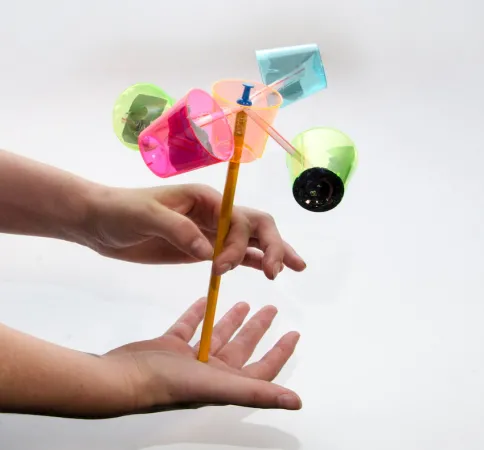
In this experiment, become a meteorologist by making an anemometer to measure wind speeds. The results might just blow you away!
What you need
- 5 small paper cups
- 2 straws
- 1 push pin
- 1 pencil (with unused eraser at the end)
- Marker
- Single-hole punch
- Scissors
- Masking or duct tape
- Stopwatch
Safety first!
Adult supervision may be needed when handling sharp push pins or scissors.
Make it
- Make a hole in four of the paper cups, about 2 cm down from the rim.
- Using the last cup, make two holes (opposite one another) about 2 cm down from the rim.
- With the same cup, make two more holes. Each hole should be 1 cm below the rim, and located between the first two (opposite one another). You should be left with four holes equally spaced apart.
- With the same cup, punch one final hole in the bottom of the cup. Make sure it is large enough for the pencil to fit through; if it isn’t, carefully use scissors to make it larger.
- Push a straw through the hole in one of the cups with one hole. On the inside of the cup, bend the straw at the end and tape it to the opposite side of the cup.
- On the cup with four holes, push the free end of the straw through one of the 2-cm-below-the-rim holes. Push it even further through the hole you made on the opposite side.
- On the free side of the straw, poke it through the hole on one of the cups. On the inside of the cup, bend the straw at the end and tape it to the opposite side of the cup.
- Repeat steps 4-6 for the remaining cups. The straw will be pushed through the 1-cm-below-the-rim holes this time.
- Push the pencil through the bottom of the base cup, eraser side up. The eraser should meet the straws as they cross.
- Push the push pin through the straws and into the eraser, making sure it is secure.
- On one of the cups with only one hole, colour in the bottom with the marker.
Test it
Hold the pencil below the base cup. Bring your homemade anemometer outside, and watch the wind spin it. To measure the speed of the wind, count how many times the coloured cup passes you within the span of one minute. Here, you are counting the revolutions per minute. The more revolutions (spins) there are, the stronger the wind is!
Explain it
Although the wind is invisible, it is a powerful force. When the air is pushed inside the cups, it fills them and pushes them forward, just like if you had pushed them with your hands. This makes the anemometer spin, and the frequency of the spins can be measured.
Observe it
Anemometers are still used in meteorology today, including cup anemometers just like yours! Many professions, such as sailing and flying, rely on accurate measurements of wind speeds. Anemometers also help scientists keep track of weather and climate patterns; if the wind begins acting unusual, action can be taken in case of an extreme weather event – like a hurricane.
Go further
In this experiment, you measured the wind speed by counting how many times the anemometer spun in a minute. Can you think of any reason that this may not be the most accurate way to measure it?
There are a few reasons, the most important being that wind speed can change pretty drastically within the span of one minute! Ten seconds of intense spinning could really bring up your measurement, without being reflective of the whole minute. How could you modify your experiment to minimize this problem?
Program Details
- View all programs at the Canada Science and Technology Museum
- View other programs related to Meteorology





